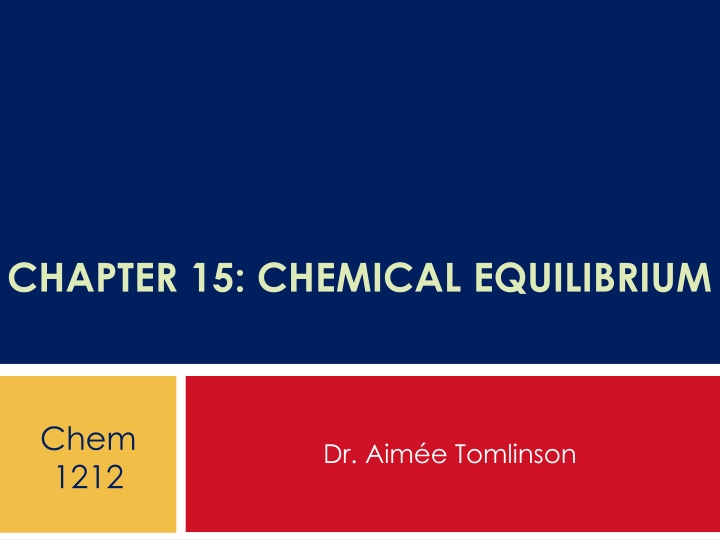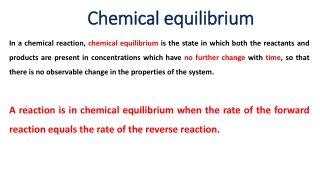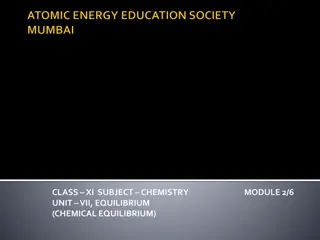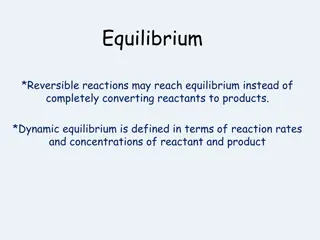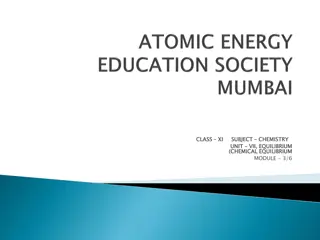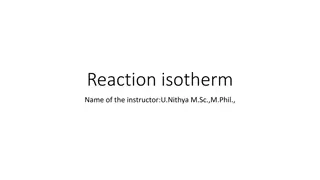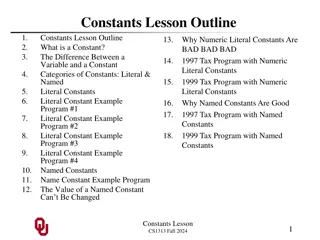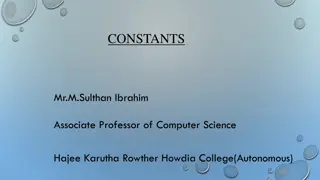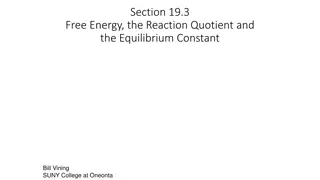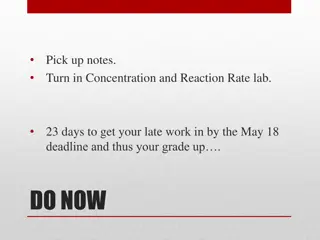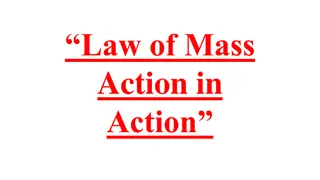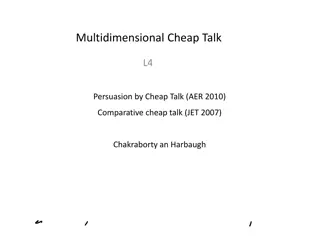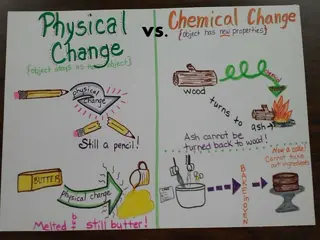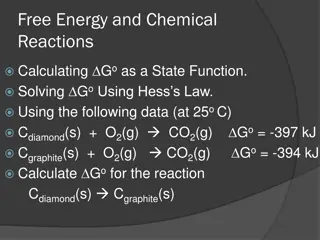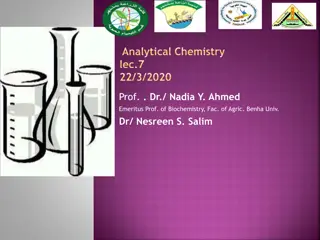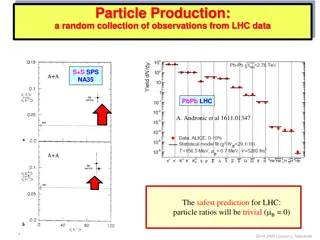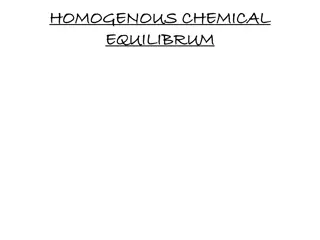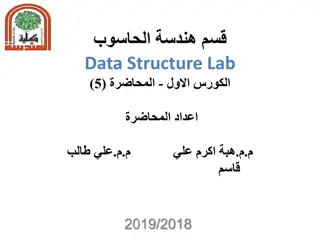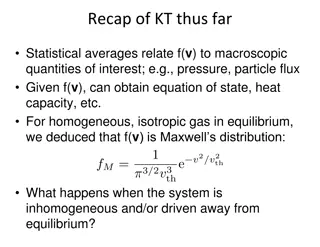Chemical Equilibrium Concepts & Equilibrium Constants
This content delves into chemical equilibrium, examining the concept, graphical representation, equilibrium constant expression, and examples related to equilibrium constants like Kc and Kp. It also covers mass action rules governing forward and reverse directions. The relationship between Kp and Kc is explored alongside examples to elucidate the concepts presented.
Download Presentation

Please find below an Image/Link to download the presentation.
The content on the website is provided AS IS for your information and personal use only. It may not be sold, licensed, or shared on other websites without obtaining consent from the author.If you encounter any issues during the download, it is possible that the publisher has removed the file from their server.
You are allowed to download the files provided on this website for personal or commercial use, subject to the condition that they are used lawfully. All files are the property of their respective owners.
The content on the website is provided AS IS for your information and personal use only. It may not be sold, licensed, or shared on other websites without obtaining consent from the author.
E N D
Presentation Transcript
CHAPTER 15: CHEMICAL EQUILIBRIUM Chem 1212 Dr. Aim e Tomlinson
Section 15.1 The Concept of Equilibrium
Graphical Representation 2 N O NO 2 NO N O 2 4( ) 2( ) g g 2( ) 2 4( ) g g colorless brown brown colorless After some time: [N2O4] stops increasing [NO2] stops decreasing Solution from brown to clear and back again Rate_forward = rate_reverse After some time: [N2O4] stops decreasing [NO2] stops increasing Solution from clear to brown and back again Rate_forward = rate_reverse
Chemical Equilibrium Defn: a phenomenon in which the concentrations of reactants and products remain constant over time N O 2 NO 2 4( ) 2( ) g g NOTE: this does not mean the concentrations go to zero! X 2
Section 15.2 The Equilibrium Constant
Equilibrium Constant Expression AKA Law of Mass Action: the chemical equilibrium expression will give rise to a characteristic value for a given temperature For the General case: c d [ ] [ ] [ ] [ ] A C D B aA bB + + = cC dD K c a b Kc is the equilibrium constant in terms of concentrations
Example c d [ ] [ ] [ ] [ ] A C D B aA bB + + = Recall: cC dD K c a b Write the Kc for both the forward and reverse directions for the following: + + 1.) 4A 3B 2C D 2 ?4?3 ?2[? ?2[? ?4?3 ?? = ??= + 2.) 3H N ??3 ?23[?2 2NH 2 2 3 3[?2 2 ?2 ??32 ?? = ??=
Mass Action Rule #1 Kc in the forward direction is the inverse for the reverse direction 1 = K ' c K c
Generalized Kp c d ( ( ) ( ) ( ) ) P P P P + + = C D aA bB cC dD K ( ) g ( ) g ( ) g ( ) g p a b A B Example: What is Kc and Kp for the reaction below. + 2 2 NO Cl NOCl ( ) g 2( ) ( ) g g ????2 ??2[??2 ??= 2 ????? ??? ??= 2(???2
How are Kp & Kc Related? We start with the ideal gas Law: n RT MRT V Using Previous Example: 2 g NO [ ] [ [ NO ( ) ( ( NO P 1 + 2 NO O = = = P M P 2( ) ( ) g 2( ) g RT 2 ] NO O = 2 K Next, we plug into the Kc expression c 2 ] 2 2 2 P RT P O NO RT 2 ) P P 2 [ ] [ ] NO NO O NO O = K 2 = = 2 K p 2 ) c 2 2 [ ] P 2 NO RT 2 2 2 ( ) ( ) 1 RT P P 1 NO P = O = = K K 2 c p 2 RT ( ) NO K RT 2 , or K p c
Kp & Kc Generalized Relationship = n ( ) K K RT p c Where n = moles(g)products - moles(g)reactants For previous example we had: + 2 2 NO NO O 2( ) ( ) g 2( ) g g So n = 3-2 = 1 hence Kp = KcRT
Another Example For which of the following will Kp = Kc? = = + 2 3 1 n 1.) 2 2 SO O SO 2( ) ( ) g 3( ) g g = = + + 1 1 0 n 2.) Fe CO FeO CO ( ) s 2( ) ( ) s ( ) g g + + = = 3.) H O CO H CO 2 2 0 n 2 ( ) g ( ) g 2( ) 2( ) g g So only 2.) & 3.) will work. X 6
Section 15.3 Understanding & Working with Equilibrium Constants
Judging the Extent of Reaction [products] [reactants] = K c Kc > 103 products predominate over reactants: reaction proceeds nearly to completion very little reactant is left Kc < 10 3 reactants predominate over products: reaction hardly proceeds at all very little product is produced 10 3 < Kc < 103 neither dominates both are present at eq
Handling Combined Equations + (1) 2 N O NO 2( ) NO 2( ) O + ( ) g NO g g (2) 2 2 ( ) g 2( ) 2( ) g g + + + 2 2 2 N O NO NO NO 2( ) 2( ) ( ) g ( ) g 2( ) g g g + : 2 2 Overall N O NO 2( ) 2( ) 2( ) g g g 2 2 2 [ N ] NO [ ] O [ N ] O NO NO NO = = = 2 O 2 K K K 2 1 overall 2 2 [ ] [ ] [ ][ ] [ ][ ] 2 2 2 2 2 2 [ N ] O NO ][ 2 2 [ ] [ [ N ] NO NO NO = = 2 2 O K K 1 2 2 [ ] [ ][ ] 2 [ ] ] O 2 2 2 2 2
Mass Action Rule #2 When adding up equilibrium equations to get an overall the product of their equilibrium constants will give rise to the Kc of the overall equation K = K K c,overall 1 2
Example Problem 2 D A + 2 B Calculate the Kc for Using the data below: A C 2 B C K K 3.3 0.041 + = = c 2 D c
How does factor multiplication impact Kc? 2 [ ][ ] [ ] D A B + = 2 2 D A B K 1 2 3 6 [ ] [ ] [ ] D A B ( ) + + = 3 2 2 6 3 6 D A B D A B K 2 6 = 3 ( ) K K 2 1
Mass Action Rule #3 Multiplying a chemical by a factor leads to exponential factor for the Kc ( ) n = ' c K K c
Summary of Mass Action Rules ACTION Reversing an eq reaction Multiplying an eq reaction by n Adding several eq reactions together New Eq Constant K c new = 1 K , c ( ) n = K K , = c new c K K K , ,1 ,2 c new c c
Example Problem If Kc = 2.4 x 10-3 for what is it for the following? 2 SO O 2 SO + 2( ) g 2( ) g 3( ) g 1.) SO O SO +1 2( ) g 2( ) g 3( ) g 2 2.) 2 SO 2 SO O + 3( ) g 2( ) g 2( ) g 3.) SO SO O +1 3( ) g 2( ) g 2( ) g 2
Section 15.4 Heterogeneous Equilibrium
The Two Types of Equilibria Heterogeneous when the reactants/products are in more than one phase Homogeneous when the reactants/products are all in the same phase
For Eq we never include: Solids [ ][ ] CO H H O + + = 2 H O C CO H K 2 ( ) g ( ) s ( ) g 2( ) g c [ ] 2 Pure Liquids [ ] H CO CO + = 2 3 CO H O H CO K 2( ) 2 ( ) l 2 3( ) g aq c [ ] 2
Section 15.5 Calculating Equilibrium Constants
Finding K with all eq concentrations What is Kc for the reaction below given the following equilibrium concentrations: [SO2]=0.15 M, [O2]=0.68, [SO3]=1.5 + 2 2 SO O SO 2( ) 2( ) 3( ) g g g
Finding K with initial & eq concentrations What is Kc for the reaction below given the initial concentrations of reactants were [SO2]=0.150M and [O2]=0.680M and the equilibrium concentration of the product is [SO3]=0.050M? 2 g g SO O + 2 SO 2( ) 2( ) 3( ) g
Finding K with initial concentrations and %dissociation What is Kc for the reaction below if the initial concentrations for both reactants is 0.500M and they will dissociate by 0.5% to reach equilibrium? + 2 2 SO O SO 2( ) 2( ) 3( ) g g g
Section 15.6 Application of Equilibrium Constants
Reaction Quotient Q Q looks just like Kc but it not guaranteed to be at eq c d [ ] [ ] [ ] [ ] A C D B aA bB + + = cC dD Q c a b
Using Q for Direction Prediction At Eq we go in neither direction Need to consume products Go reverse To the left Toward reactants Need to consume reactants Go forward To the right Toward products
Example Practice with Q Given the data below is the reaction in equilibrium and if not in which direction will need to go in order to reach eq? 22, K A A B = B = = 0.10 , 2.0 M M
Finding Equilibrium Concentrations We use the "ICE" table: "I"nitial "C"hange "E"q
ICE Example I The value of Kc = 0.0900 at 298K for the reaction below, determine the eq concentrations if initially [H2O] = 0.00432 M and [Cl2O] = 0.00442 M. H O Cl O + 2 HOCl 2 ( ) g 2 ( ) g ( ) g
ICE Example II The value of Kc for the thermal decomposition of hydrogen sulfide 2 g H S + 2 H S 2 ( ) 2( ) 2( ) g g is 2.2 x 10-6 at 1400K. A sample of gas in which [H2S] = 0.600M is heated to 1400K in a sealed vessel. After chemical eq has been achieved, what is the value of [H2S]? Assume no H2 and S2 was present in the original sample.
ICE Example III What are the eq concentrations of each of the species in the following reaction, given the Kc = 5.1 at 700K and the initial concentration of all species is 0.050 M? CO H O + + CO H ( ) g 2 ( ) g 2( ) 2( ) g g X 5
Section 13.6-13.9 Le Ch telier s Principle
Le Chteliers Principle Defn: when a stressor is applied to a system at equilibrium, the system will adjust to counteract the stressor in order to reestablish equilibrium Stressors include: Adding or removing reactants or products Changing the pressure or the volume Changing the temperature
Stressor I: Concentration Changes A B Increase in A or decrease in B: [ ] [ ] A B = Q K We will need to consume A (or produce B) to get back to eq We go: Forward Toward product To the right Increase in B or decrease in A: [ ] [ ] A B = Q K We will need to consume A (or produce B) to get back to eq We go: Reverse Toward reactant To the left
Stressor II: P or V Changes 2 A B ( ) g ( ) g Decrease V or increase P: [ ] [ ] A B = Q K 2 We increase the number of collisions between molecules P will increase and V will decrease Number of moles appears to increase We go: Forward Toward product To the right Increase in V or decrease in P: [ ] [ ] A B = Q K 2 We decrease the number of collisions between molecules P will decrease and V will increase Number of moles appears to decrease We go: Reverse Toward reactant To the left
LCP Example I For each scenario predict the direction the reaction goes to attain eq: + CO 2H CH OH (g) 2(g) 3 (g) a.) CO is added b.) CH3OH is added c.) Pressure is reduced d.) Volume is increased
Stressor III: Temperature Changes Unique since this stressor will also change the value for Kc For exothermic reaction, heat is a product Reactants Products + H Removal of heat will force the reaction to go: Forward Toward product To the right Addition of heat will force the reaction to go: Reverse Toward reactant To the left For endothermic reaction, heat is a reactant H + Reactants Products Addition of heat will force the reaction to go: Forward Toward product To the right Removal of heat will force the reaction to go: Reverse Toward reactant To the left
LCP Example II In what direction will the eq shift when each of the following changes are made to the system at eq? 2 g N O NO = 58.0 H kJ ( ) ( ) g 2 4 2 a.) N2O4 is added b.) NO2 is removed c.) Pressure is increased by adding N2 d.) Volume is decreased e.) Temperature is decreased X 9
